Renewable Energy Development Thrives During China’s 12th Five-Year Plan
China’s 12th Five-Year Plan calls for expanding the use of renewable energy in all forms throughout the country. From solar and wind to biomass gas and briquettes, China has a true “all of the above” renewable energy policy.
Renewable energy, in all its forms, is an important part of China’s sustainable electricity system development. Accelerating the development and use of renewable energy has become an effective and efficient way for China to respond to the increasingly serious problems of increasing energy supply while minimizing environmental impact.
This article examines the renewable energy portion of China’s 12th Five-Year Plan, from development to implementation over the period 2011 to 2015 and provides an update on renewable energy accomplishments made during the 11th Five-Year Plan (2006–2010). For each renewable technology, practical suggestions are provided that would further strengthen the plan’s goal of bringing electricity to all while reducing China’s use of fossil fuels.
China’s Renewable Program
Renewable energy plays an important part in China’s overall energy plan. Its use has many favorable outcomes, such as wide resource distribution, high exploitation potential, reduced environmental impact, and sustainable use. China’s rapid economic and social development has made energy demand growth, resource depletion, and environment pollution increasingly serious. The development and use of renewable energy has become an important means for China to guarantee its energy security and to strengthen environmental protection. Therefore, accelerating the development and use of renewable energy is a necessary way for China to simultaneously address the serious problems of energy supply and environmental protection.
The renewable energy goals set for the 12th Five-Year Plan are substantial, as was discussed in an earlier article (“China’s 12th Five-Year Plan Pushes Power Industry in New Directions,” January 2012, available in the POWER archives at https://www.powermag.com). Renewable energy development is key to China achieving its goal of 11.4% of primary energy consumption from non-fossil sources in 2015 and 15% in 2020. It’s also necessary to speed up renewable energy policy changes and to promote the sustainable development of its renewable energy industry. The current plan builds on the success of the 11th Five-Year Plan, during which the 2005 Renewable Energy Law was made effective, renewable energy markets were established, renewable resource evaluations were completed, and many renewable projects began construction (Table 1). Today, many renewable energy technologies have been commercialized, and the markets for their use are quickly expanding. China’s renewable energy industry has now entered the next stage of development: comprehensive, fast, and large scale.
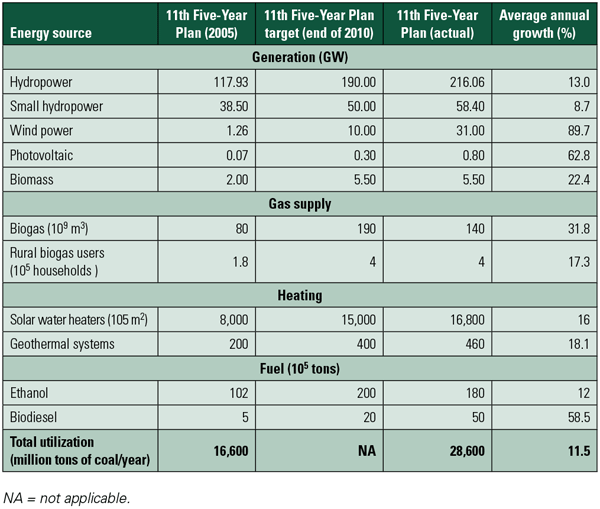 |
| Table 1. Major indicators of renewable energy development during the 11th Five-Year Plan. Source: State Council (www.gov.cn) |
Technology and Market Challenges
Renewable energy, in its many forms, is now an important part of China’s national energy development strategy. However, significant challenges remain before China can reach its renewable energy goals.
Technical and economic problems of renewable energy development are still China’s most fundamental problems. In recent years, renewable energy technology has improved rapidly, but most renewable energy industries are still in a growth phase, except hydropower and solar water heaters. The growing markets have experienced uneven distribution of products and many manufacturing disruptions. The cost of development and use of the products also remains high. Renewable energy still lacks competitiveness under current market circumstances, so it is necessary for China to rely on policy support to sustain development.
Furthermore, management systems and market mechanisms are having difficulty adapting to full-scale development of renewable energy. The operational characteristics of large, conventional energy resources are much different than those of relatively small and distributed renewable energy resources now operating. Also, the effect of intermittent operation of renewable energy sources has become more apparent as the use of renewable sources grows. Consequently, China has found it necessary to establish new power management systems, market mechanisms, and technical support systems to handle large amounts of renewable electricity.
Additionally, China is working to develop a system of basic research, technological innovation, and competitiveness—although that effort is still in process. A large gap remains between China and developed countries when it comes to key technologies for renewable energy. However, China is constantly improving the training of those who will work in the country’s renewable energy industry.
Renewable Goals During the 12th Five-Year Plan
According to the 12th Five-Year Plan, renewable energy use of all forms will expand considerably. In addition, the plan promotes the fusion of renewable energy and conventional energy systems, invests in technology innovation and core technologies, and establishes a strong, fully functioning renewable energy industry (Table 2).
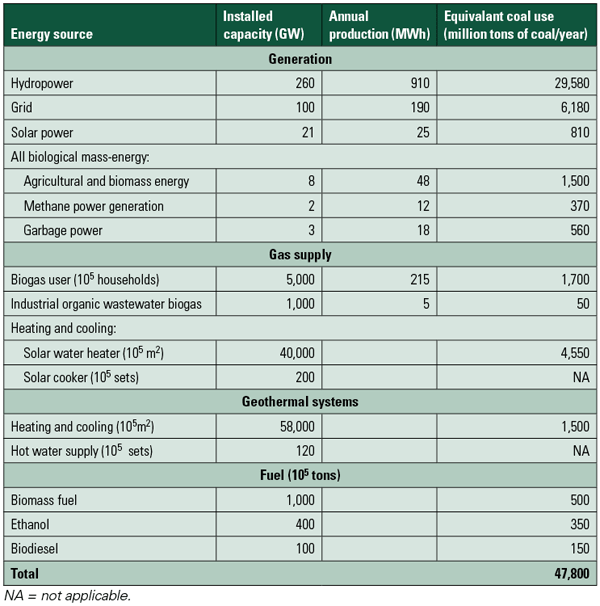 |
| Table 2. Major renewable energy development is planned during the 12th Five-Year Plan. Significant reduction in the amounts of equivalent fossil fuels result. Source: State Council |
The measure chosen to track accomplishments is equivalent tons standard coal usage that is offset by renewables. For example, by 2015, annual utilization of renewable energy resources is expected to reach 0.47 billion tons standard coal, of which 0.4 billion tons are commercialized renewable resources or about 9.5% of China’s energy consumption.
Renewable energy generation is expected to reach over 20% of total generation by 2015. New installed renewable energy capacity is planned to be 1,600 GW, of which 610 GW will be from conventional hydropower, 700 GW from wind power, and 75 GW from biological mass-energy (biomass).
By 2015, annual renewable energy resources to replace fossil energy for heating and civil fuels (fuels used to heat and/or power government and other buildings) will be equivalent to about 100 million tons standard coal. Expansion in the use of solar thermal energy, promoting the direct use of medium- and low-temperature geothermal energy and heat pump technology, increasing the use of biomass briquettes, expanding the use of biomass combined heat and power generation, and speeding up the development of biogas and other biomass gases are all very important for China to achieve its renewable energy goals.
China must expand its power grid hardware and management systems to handle the power produced by large-scale renewable projects. While that work continues, the 12th Five-Year Plan adds more, including the construction of 30 new energy microgrid demonstration projects, 100 new energy demonstration cities, and 200 green energy demonstration counties (each discussed in more detail later in this article). These projects will integrate diverse renewable energy technologies, such as distributed power generation and renewable energy heating and fuel utilization. The target penetration of distributed renewable energy in rural areas is above 50%.
Large-scale renewable projects and the policy systems required to support renewable energy development remain a large part of the renewable energy portion of the 12th Five-Year Plan. In fact, the plan calls out eight specific renewable energy categories for development. Each is described in the following sections.
Hydropower Flourishes
By 2020, the total installed hydropower capacity in China will reach 420 GW, with conventional hydropower at 350 GW and pumped-storage power stations at 70 GW, according to the National Energy Administration.
The key goals for developing new hydropower should include close government coordination to improve the well-being of those relocated to make way for a new hydropower project, as well as the stated goals of environment protection, local economic and social development, and strengthening hydropower planning.
During the 12th Five-Year period, the total installed capacity of all hydropower projects is planned to increase by 160 GW, with 40 GW of new pumped-storage power stations. Of that 160-GW increase, 74 GW will be new hydropower installations—of which small hydropower plants would provide 10 GW plus 13 GW of pumped-storage capacity. By 2015, total installed hydropower capacity will reach 290 GW, 260 GW of which will be from conventional hydropower and 30 GW from pumped-storage power stations. By then the installed capacity of existing conventional hydropower projects will account for 48% of national technically exploitable capacity (TEC), according to the National Energy Administration.
By 2015, conventional hydropower capacity installation in the western region alone will reach 167 GW, accounting for 64% of China’s total installed capacity, with a development level of 38% TEC. In central China, conventional hydropower capacity installation will reach 59 GW, accounting for 23% TEC, and in eastern China it will reach 34 GW, accounting for 13% TEC. At the same time, the National Energy Administration predicts the national installed capacity of pumped-storage power stations will reach 40 GW, mainly distributed in eastern and central parts of China, of which 20.7 GW will be from eastern regions, 8 GW from the central areas, and 1.3 GW from western areas.
River Basin Hydropower. The central government must strengthen preliminary work such as river hydropower planning and continue to support the demonstration of Longtou reservoir’s construction in the middle reaches of the Jinsha River, and conduct strategic planning for developing hydropower in southeastern Tibet. The government should put priority on the “Three Rivers” (Jinsha, Lancang, and Nujiang) and the basic research work on the “West-East” electricity transmission project. Priority should be given to continuing hydropower planning work on the Yalong River Up Reaches and Brahmaputra River Lower Reaches and the completion of hydropower planning for the Jinsha River Up Reaches, Lancang River Up Reaches, Yellow River Up Reaches, Brahmaputra River Middle Reaches, Nujiang River and Tongtianhe River, among others.
Large Hydropower. It is necessary to accelerate the construction of large hydropower stations by concentrating on those regions with abundant hydropower resources and on better construction conditions, such as the middle and lower reaches of the Jinsha River, Yalong River, and Dadu River; the middle and lower reaches of Lancang River; Yellow River Up Reaches; and Brahmaputra River Middle Reaches—among others. The government must continue to implement capacity enlargement and upgrade hydropower resources in central and eastern regions.
The distribution of China’s 13 largest hydropower projects is shown in Figure 1.
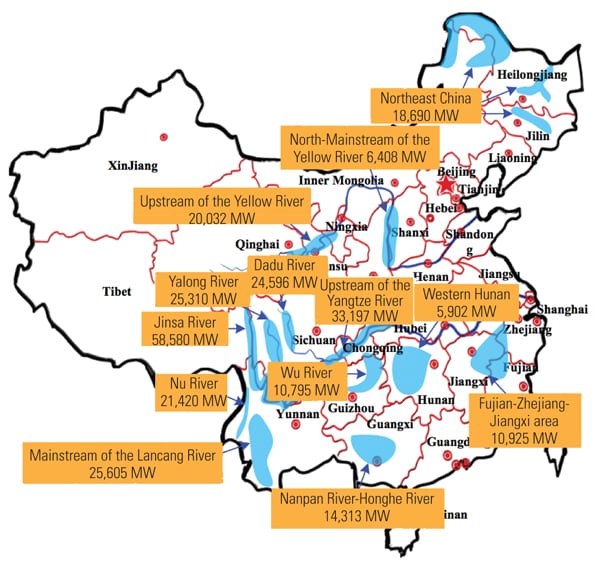 |
| 1. Many hydro plants. This map shows the location of China’s 13 largest hydropower plants. Source: China Electricity Council (www.cec.org.cn) |
Small Hydropower. The central government must strengthen the comprehensive management of small and medium-sized river basin projects, promote hydropower capacity enlargement and efficiency increases, and improve the development and utilization of small hydropower in poor areas with abundant resources. By 2015, the construction of small hydropower projects in large provinces worth 3 GW and small hydropower in five small provinces worth 5 GW will be completed.
Pumped Storage. In accordance with the principle of “integrated planning, rational distribution,” the construction of pumped-storage power stations will be accelerated moderately. In regions where the proportion of new energy (that is, non-hydro renewable) systems is high, the government should construct pumped-storage power stations to increase the flexibility and reliability of power system operation.
In eastern coastal areas that import most of their electricity, the government should rationally arrange a number of pumped-storage power stations to ensure the security and stability of the electrical network. China’s major hydropower stations and pumped-storage projects under construction during the 12th Five-Year Plan are shown in Tables 3 and 4.
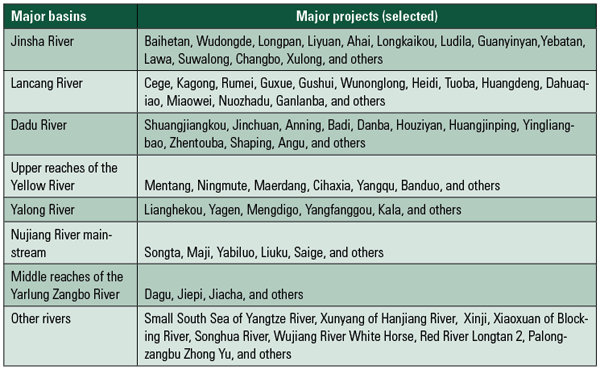 |
| Table 3. Hydro plans. China will have started or will continue construction of many major hydropower stations and pumped-storage projects during the 12th Five-Year Plan. Source: China Electricity Council |
 |
| Table 4.Pumped storage. China has many major pumped-storage projects under construction during the 12th Five-Year Plan. Source: China Electricity Council |
Wind Power Increases
By 2015, the cumulative grid-connected wind power capacity will reach 100 GW, and the annual generated energy will surpass 190 billion kWh. Offshore wind power capacity will reach 5 GW, according to the National Development and Reform Commission. A complete wind power equipment manufacturing industry that will compete in the international market also will be formed. By 2020, the cumulative grid-connected wind power capacity will reach 200 GW, and the annual generated energy will surpass 390 billion kWh. Offshore wind will reach 30 GW. By 2020, wind power will have become an essential part of China’s power system.
The government should continue to promote the large-scale development of wind power, although development must be equally split between centralized and decentralized projects. Wind power resource distribution, power transmission, and electricity consumption must be carefully coordinated. At the same time, it is necessary to optimize wind power development and distribution, establish suitable dispatching and operating methods to improve utilization efficiency, enhance the global competitiveness of equipment, and improve the wind power service system. The development pace of wind power will increase during the 12th Five-Year Plan.
By 2015, several concentrated development areas with a capacity of more than 5 GW will be completed, such as Jiuquan, Zhangjiakou, Ulanqab, Xilin Gol, Tongliao, Chifeng, and Baicheng. There will also be a couple of concentrated development areas with a capacity of more than 2 GW, such as Chengde, Bayannur, Baotou, Xing’an, Matsubara, Tangshan, Minqin, Daqing, and Qiqihar. China’s eight planned wind power sites with a capacity of more than 10 GW are shown in Figure 2.
 |
| 2. Many large wind projects. China is planning eight wind power sites with a total capacity of more than 10 GW that will be constructed by 2015. Source: National Development and Reform Commission (www.sdpc.gov.cn) |
The central government should strengthen the wind energy resource assessment of inland areas, except the “Three-North” region, as well as development and construction in those areas. It should also accelerate wind power development in regions with richer resources and better grid access conditions, such as Shanxi, Liaoning, Ningxia, and Yunnan, among others, and encourage constructing small and medium-sized wind power projects connected to the grid, as local conditions allow. This allows local wind energy resources to be consumed locally, which reduces the new grid capacity needed.
Transformer substations with voltages below 110 kV are widely distributed and near load centers. The central government will connect wind turbines with appropriate capacity to the nearby grid but should also explore the option of combining wind power with other distributed energy sources to satisfy local electricity needs.
The government should accelerate the resource assessment of offshore wind energy, geological surveys, construction, and other work preparations. It should also actively coordinate the relationship between offshore wind power construction and marine environmental protection. Offshore wind power should be focused on coastal provinces such as Jiangsu, Shanghai, Hebei, Shandong, Liaoning, Guangdong, Fujian, Zhejiang, Guangxi, Hainan, among others. Overall planning and construction should be sensitive to local conditions. Also, the government should explore the development of offshore wind power demonstration projects in deeper waters or waters distant from shore. The distribution of wind power development and construction is shown in Table 5.
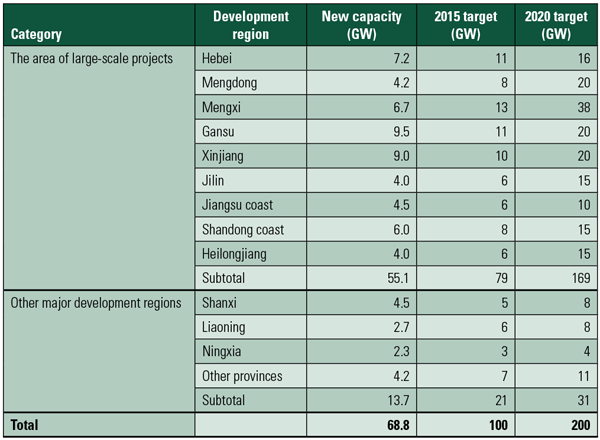 |
| Table 5. Rapidly rising wind. China has many very large wind projects under development or under construction during the 12th Five-Year Plan. Source: National Development and Reform Commission |
Solar Energy Spreads
By 2015, the annual utilization of solar energy will be equal to 500,000 tons standard coal. The installed capacity of solar power generation will reach 21 GW, of which 10 GW will be from photovoltaic (PV) power plants, 1 GW from solar thermal power generation, and 10 GW from grid and off-grid distributed PV systems (Table 6). The total cumulative area used for solar thermal generation will be 400 million square meters. By 2020, the installed capacity of solar power generation will reach 50 GW, and the total cumulative area for solar thermal will be 800 million square meters, according to the National Development and Reform Commission.
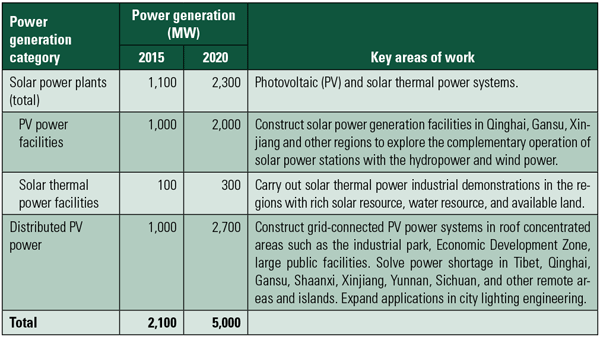 |
| Table 6. Solar systems. Solar power systems of all types will greatly expand during China’s 12th Five-Year Plan. Source: China Electricity Council |
The government should begin solar thermal power industrial demonstrations. The government should also promote the diversified utilization of solar energy and encourage construction of PV power plants in regions with rich solar resources and excess land that has no other use.
Solar energy plants (perhaps combined with wind power plants) should be combined with hydropower development to simplify grid access, such as in Qinghai, Gansu, Xinjiang, and other regions.
Distributed PV. The government should support the construction of distributed PV power plants to solve electricity shortages in remote areas. In addition, the central government should speed up the use of solar water heaters and expand their use in civil and public buildings in urban and rural areas, and promote the building of solar houses and use of solar cookers in rural areas.
Distributed PV power systems in areas with abundant solar resources could be constructed as a microgrid system with other new energy supplies, such as biomass energy, and energy storage technologies. The government should promote household PV systems or small PV power stations in remote areas without electricity or in power-shortage areas. It also should encourage the use of distributed PV power for communications, transportation, and lighting.
Solar Thermal. The government should construct demonstration projects of solar thermal power generation and improve system integration of high-temperature solar collector tubes, condensers, and other key technologies and equipment manufacturing capacity. The government should choose suitable locations in regions such as Inner Mongolia Erdos Heights, the flat desert along the Yellow River, the Hexi Corridor in Gansu Province, the Turpan Basin and Tarim Basin region, Lhasa Tibet, Qinghai, Ningxia, and similar locations.
Biomass Energy Multiplies
According to the National Development and Reform Commission, by 2015, annual biomass energy utilization in China will be equivalent to 50 million tons of standard coal. The installed capacity of biomass power will reach 13 GW, annual biogas utilization will be 22 billion cubic meters, 10 million tons of biomass briquettes will be used, 350 million to 400 million tons of biomass alcohol will be used, and 1 million tons of biodiesel and aviation biofuel will be used.
Various types of biomass resources should be coordinated to maximize efficiency of use. Based on local economic conditions, the best biomass technology and market-oriented approaches to development should be selected. Biomass technology used also should promote rural economic development, improve farmers’ income, and improve the environment.
In regions producing grain and cotton, the government should optimize the distribution of the construction of biomass power generation projects using crops, straw, food processing residues, cane bagasse, and so on as fuel. In major forested areas, logging slash, bucking residues, processing residues, tending thinning resources, and fast-growing forest resources should be combined with forestry ecological construction. The government also should encourage biomass-fueled poly-generation projects that can produce gas, liquid fuels, chemical products, power generation, and space heating.
Biomass Gas. The government should take full advantage of rural straw, solid waste, forestry residues, and livestock waste by actively promoting the construction of small-, medium-, and large-scale biogas and biomass gasification gas projects. It also should encourage biomass gas (biogas) purification and compression to commercialize the use of biomass gas. By 2015, the number of users supplied by biomass concentrated gas is targeted to reach 300 million.
Biomass Briquettes. Central heating using biomass briquettes should be promoted in urban areas and biomass briquettes should be widely used in rural areas as a clean cooking and heating fuel. A system involving biomass briquettes production supply, transportation, storage, and use should be established in both urban and rural areas.
Biomass Liquid Fuel. The central government should develop marginal land, such as saline land, grassland, and mountain slopes, to construct non-grain biomass resource supply bases followed by development of bio-liquid fuel.
Rural Renewable Energy Develops
By 2015, the number of national biogas users will be up to 50 million, and more than 50% of suitable farmers will get access to biogas. Meanwhile, the coverage area for solar water heater use in rural areas will be more than 80 million square meters, and the number of solar cookers will be up to 2 million units. Most importantly, everyone will have access to electricity.
The government should be focused on meeting the unique energy needs of rural areas for cooking, heating, production, and essential electricity uses. Rural renewable energy development is an important part of new rural construction.
Electricity for Rural Areas. The government should promote the construction of power generation centers in regions without electricity: Inner Mongolia, Yunnan, Sichuan, Tibet, Qinghai, Xinjiang, and other provinces (or autonomous regions). In remote areas where the grid is difficult to extend in a short amount of time, it is urgent to take advantage of local renewable energy resources, according to local conditions, such as by constructing small hydropower, small wind power generation, solar PV systems, and so on. In this way, all administrative villages will have access to electricity and the problem of electricity shortage will be solved.
Rural Clean Energy Development. Forestry residues, livestock waste, rural garbage, and other renewable energy resources should be used, according to local conditions, to construct household biogas, small and medium-sized biogas plants, and larger biomass gasification projects. The central government should promote biomass briquettes to provide clean biomass fuels for farmers and advance clean energy consumption in rural households for cooking and heating.
Geothermal Energy Gains
The National Development and Reform Commission predicts that by 2015, the total amount of various types of geothermal energy development will reach 100 MW and utilization will amount to the equivalent of 15 million tons standard coal. Buildings heated and cooled using shallow geothermal energy (heat pump technology) will amount to 500 million square meters.
The government should accelerate the geothermal resources survey, strengthen the planning and management of geothermal development, and increase the amount of geothermal energy development and utilization. The direct use of geothermal energy should be encouraged, particularly the development of shallow geothermal energy used in building heating and cooling.
Geothermal Power Generation. The government should construct several megawatt-class geothermal power stations along the Qinghai-Tibet Railway in southwestern Yunnan and other high-temperature resource regions to provide power to meet the needs of western development. Small and medium-sized distributed geothermal power generation projects should be developed along the eastern coast and the northern piedmonts of Tianshan and other medium- and low-temperature resource regions.
Shallow Geothermal Energy Use. The central government should encourage the accelerated development of shallow geothermal energy heating in the northeast, northwest, and other extremely cold regions. Shallow geothermal energy heating and cooling should be encouraged in hot summer and cold winter regions, such as the Huang-Huai-Hai River Basin, Fen River Basin, and Weihe Basin; middle and lower reaches of the Yangtze River, Chengdu, and Chongqing; and regions such as Guangdong, Guangxi, southeastern Fujian and Hainan, as well as the Yunnan-Guizhou Plateau.
Marine Energy Industry Launches
The government should actively carry out the construction of marine energy demonstration projects, promote the technical progress of marine energy use, and invest in improvements to the marine energy equipment industry. These improvements are required for the marine energy industry to grow.
The government should construct independent demonstration power stations near islands with electricity demand, where there are rich marine energy resources, and locate them near where offshore wind projects are planned to reduce electricity transmission problems. The government also should invest in energy storage technologies to solve the electricity supply problems of some islands with power shortages.
Tidal energy technology and equipment is available. Therefore, one or two 10-MW-class tidal power stations should be installed in qualified areas, as well as several tidal current energy grid-connected demonstration power stations. By 2015, various types of marine energy power plants with a total capacity of 50 MW could be completed, laying the foundation for future development.
Demonstration Projects Required
Some technologies are in the early development stage and are deserving of further full-scale testing. The following are suggestions about which technologies should be given field trials.
Renewable Demonstration Counties. By 2015, 200 green energy demonstration counties and 1,000 solar model villages should be completed. In regions with rich renewable energy resources, the central government should establish renewable energy demonstration counties, where full-scale renewable technologies of all types work together. In addition, the government should support the development of small and medium-sized renewable energy facilities for small towns to meet their specific electricity, gas, heating, and other energy needs.
New Energy Model City. By 2015, 100 new energy demonstration cities and 1,000 new energy demonstration parks should be completed. The government should support the promotion of the comprehensive application of solar energy, biomass, geothermal, and other new energy technologies in cities and industrial parks. The government should also accelerate the applications of renewable energy in buildings, form new energy utilization areas, and replace coal-fired and other old technology energy systems.
The program should be focused on public institutions, schools, hospitals, hotels, concentrated residential areas, solar water heating systems, distributed PV power generation, ground source heat pump technology, and biomass briquette use. In addition, the government should support carrying out a wide range of new energy technology demonstrations as part of this new construction and renovation of various industrial parks, to meet electricity, heating, cooling, and other energy needs.
New Energy Microgrid Demonstration Projects. By 2015, 30 new energy microgrid demonstration projects should be completed, supported by smart grid and energy storage technologies in which the new energy technologies discussed in previous sections of this article play an important role.
Policy Outlook
The following policies and measures should be taken during the 12th Five-Year Plan period in order to fully meet these technology development and construction tasks and to meet the target of a fully developed renewable energy industry:
- Develop an appraisal system for renewable energy development. In accordance with the requirements established by the Renewable Energy Law, a comprehensive project appraisal system must be developed that will help guide the development of future renewable energy projects. The criteria should consider the region’s renewable energy needs, as each region is very different in the types of renewable energy available, distribution infrastructure, and energy use patterns.
- Establish a quota system for renewable energy power. The demand for non-hydro renewable energy will require each province, region, and municipality to set power development, electricity market, grid structure, and power transmission system goals. Governments at all levels will assume administrative management responsibility for the task, while power grid enterprises will remain responsible for their systems in their service areas.
- Introduce renewable energy subsidies and financial and tax policies. China needs to further improve renewable energy subsidies and its financial and tax policies to support renewable energy development. For example, the government should implement a credit policy that will promote clean energy development and improve the loan support mechanism for small-scale renewable energy projects.
Final Thoughts
Generally speaking, there are more advantages than disadvantages to the environment and society with the development and utilization of renewable energy. China places considerable importance on its renewable energy development program, which also benefits the country’s sustainable development and environment-friendly policies. Simultaneously, renewable energy is an important part of an emerging strategic industry, and promoting renewable energy development will bring comprehensive economic and social benefits.
— Zeng Ming, Lü Chunquan ([email protected]), Ma Mingjuan, Peng Lilin, Yan Binjie, Li Na, and Xue Song, North China Electric Power University, Beijing, China. The Energy Foundation supported the work described in this article (G-1006-12630).